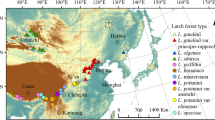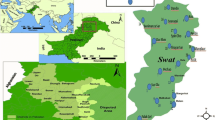Abstract
To discover the site adaptability and density suitability of Larix principis-rupprechtii as a water conservation forest in Wutai Mountain, Shanxi Province, the growth process and diameter distribution characteristics of 10-year-old artificial L. principis-rupprechtii forests with density structures of 2600 trees/hm2 and 3500 trees/hm2 were studied using trunk analysis of a sample tree. The results showed that: 1) The tree height increment of the two kinds of forests were the same, and it was almost not affected by density. However, the growth process of the diameter and timber volume showed a great distinction. The growth status and density structure of the low density forest were superior to the high density forest. 2) The skewness (S k) of diameter distribution had great distinction. The S k (0.01) of the low density forest approached a normal distribution, which showed that the density structure was reasonable, while the S k (0.45) of the high density forest was partial to a normal distribution, which showed that the density structure was on the high side. The kurtosis (K) of the two forests (one was −0.64, the other was −0.74) had little distinction and the density factor had limited function to forest polarization. 3) The increment of diameter at breast height, timber volume and trunk stock of the low density forest increased yearly without the effect of density. However, the increment of high density forests had declined from the sixth year, which was restricted by high density. 4) The reasonable density of the 10-year-old L. principis-rupprechtii artificial forest was about 2600 trees/hm2, which is also the reasonable planting density if the utilization of double cutting is not considered.
Similar content being viewed by others
References
Chai B F, Zhang J T, Qiu Y (1999). Study on the aboveground biomass and productivity of larix principis-rupprechtii artificial forest in west of Shanxi province. Henan Sci, 17(Spec): 68–71 (in Chinese)
Chen G H, Zhang Q H (1996). The research on model of eco-forest engineering in granite gneiss region of Taihang Mountain. For Res, 9(Suppl.): 1–19 (in Chinese)
Chen L X (2003). Influence of fertilization on bio-chemical activeness of rhizosphere soil in larch plantations. J Soil Water Conserv, 17(3): 133–136 (in Chinese)
Cheng J H, Zhang H J, Shi Y H (2003). Research review of forest floor’s effect on soil and water conservation. Sci Soil Water Conserv, 1(2): 96–101 (in Chinese)
China Silva Editing Committee (1981). Affoerstation Techniques of Marine Tree Species in China. Beijing: China Forestry Publishing House (in Chinese)
He C G (2004). Approach to problems about natural ecorestoration project of soil and waterconservation. Sci Soil Water Conserv, 2(3): 99–102 (in Chinese)
Huang W D, Zhang L J (1989). Diameter distribution dynamics of stands in agro-forestry system. J Nanjing For Univ, 13(4): 86–91 (in Chinese)
Ji Y Z, Chen L X (2003). Fertilization on soil P availability in different developing phase of larch plantation. J Soil Water Conserv, 17(3): 41–43 (in Chinese)
Li H F (2006). Ecological restoration and soil and water conservation. Sci Soil Water Conserv, 4(1): 10–14 (in Chinese)
Li J Y (2003). Promote the soil and water wonservation of forest by best management practices. Sci Soil Water Conserv, 1(1): 53–59 (in Chinese)
Li S R, Li W Q, He K N (2003). Preliminary studies on eco-environmental water consumption of Shanxi. Sci Soil Water Conserv, 1(1): 45–48 (in Chinese)
Liu S Y, Zuo C Q, Meng J L (2004). Soil and water conservation and national ecological security. Sci Soil Water Conserv, 2(1): 102–104 (in Chinese)
Ma P A, Guo Q B (1999). Study on soil and water conservation benefits of vegetation in granite gneiss region of Taihang Mountain. Geogr Territ Res, 15(3): 43–46 (in Chinese)
Ma Z Q (2000). Shanxi Folia. Beijing: China Science Technology Publishing House (in Chinese)
Shen G F (2001). Silvivulture. Beijing: China Forestry Publishing House (in Chinese)
Sun S X (1990). Silvics (2nd edition). Beijing: China Forestry Publishing House (in Chinese)
Wang B R, Wang B T (1996). Runoff forest in Loess Plateau. Beijing: China Forestry Publishing House (in Chinese)
Wang K Q, Wang B T, Wang B R (2002). Studies on the growth of forests with different density in the system of afforestation by water-harvesting. Sci Silv Sin, 38(2): 54–60 (in Chinese)
Wang L X (2003). On the concept and category of the soil and water conservation science in China. Sci Soil Water Conserv, 1(2): 108–110 (in Chinese)
Wei Z C (2001). Forest Measurements. Beijing: Higher Education Press (in Chinese)
Xu Z H, Zhang J Y, Wang X Y (2003). Systemic thought about sustainable development of conversion of cropland to forest. J Soil Water Conserv, 17(1): 41–44 (in Chinese)
Yang W X (1996). The preliminary discussion on soil desiccation of artificial vegetation in the northern regions of China. Sci Silv Sin, 32(1): 78–85 (in Chinese)
Zhai M P (2003). Concept for vegetation rehabilitation and construction in the north-west region of China. Sci Soil Water Conserv, 1(1): 60–63 (in Chinese)
Zhang G C, Liang Y T, Long Z R (1999). The research on forestation density of man-made Robinia pseudoacacia clones. J Shandong Agric Univ, 30(Spec): 118–128 (in Chinese)
Zhou Z F, Lin F R, Song J H (2003). Study on ecological protective functions of water conservation forest managed with different measurements. For Res, 16(2): 189–195 (in Chinese)
Author information
Authors and Affiliations
Corresponding author
Additional information
__________
Translated from Science of Soil and Water Conservation, 2007, 5(1): 1–6 [译自: 中国水土保持科学]
About this article
Cite this article
Zhang, G., Xia, J., Zhang, S. et al. Density structure and growth dynamics of a Larix principis-rupprechtii stand for water conservation in the Wutai Mountain Region of Shanxi Province, North China. Front. For. China 3, 24–30 (2008). https://doi.org/10.1007/s11461-008-0003-1
Issue Date:
DOI: https://doi.org/10.1007/s11461-008-0003-1




